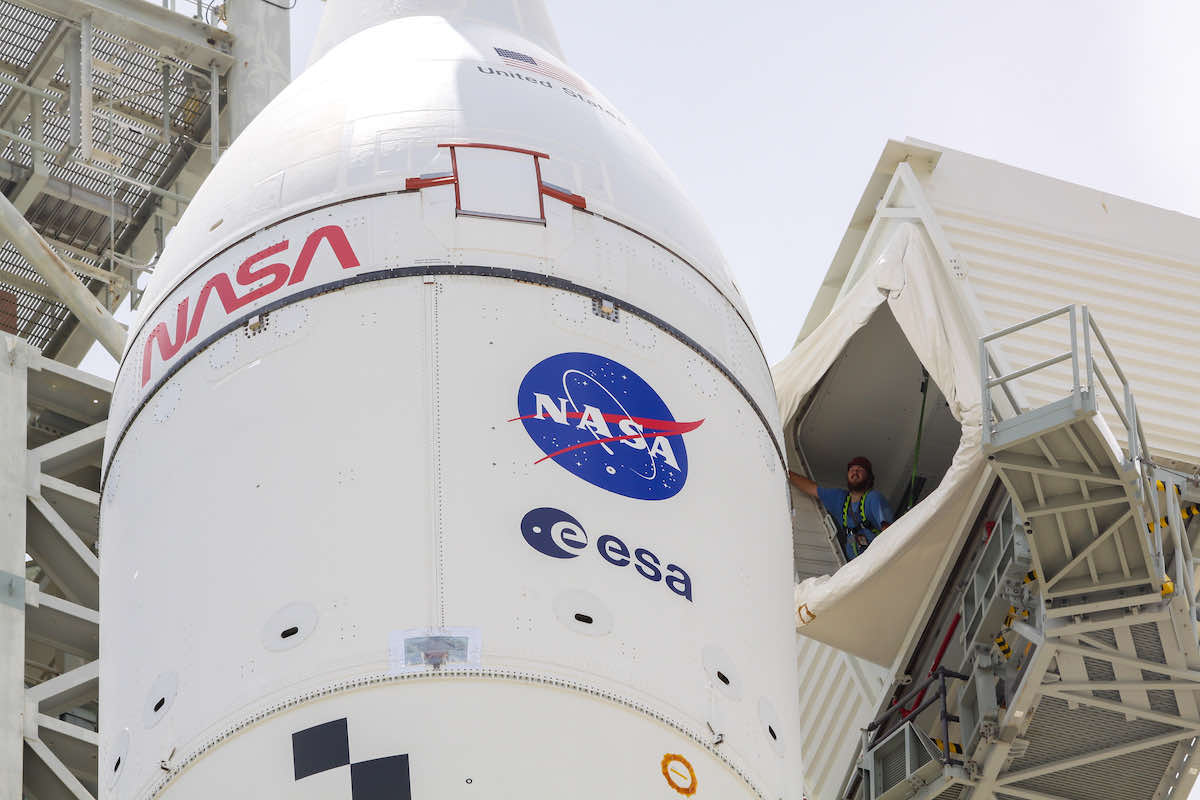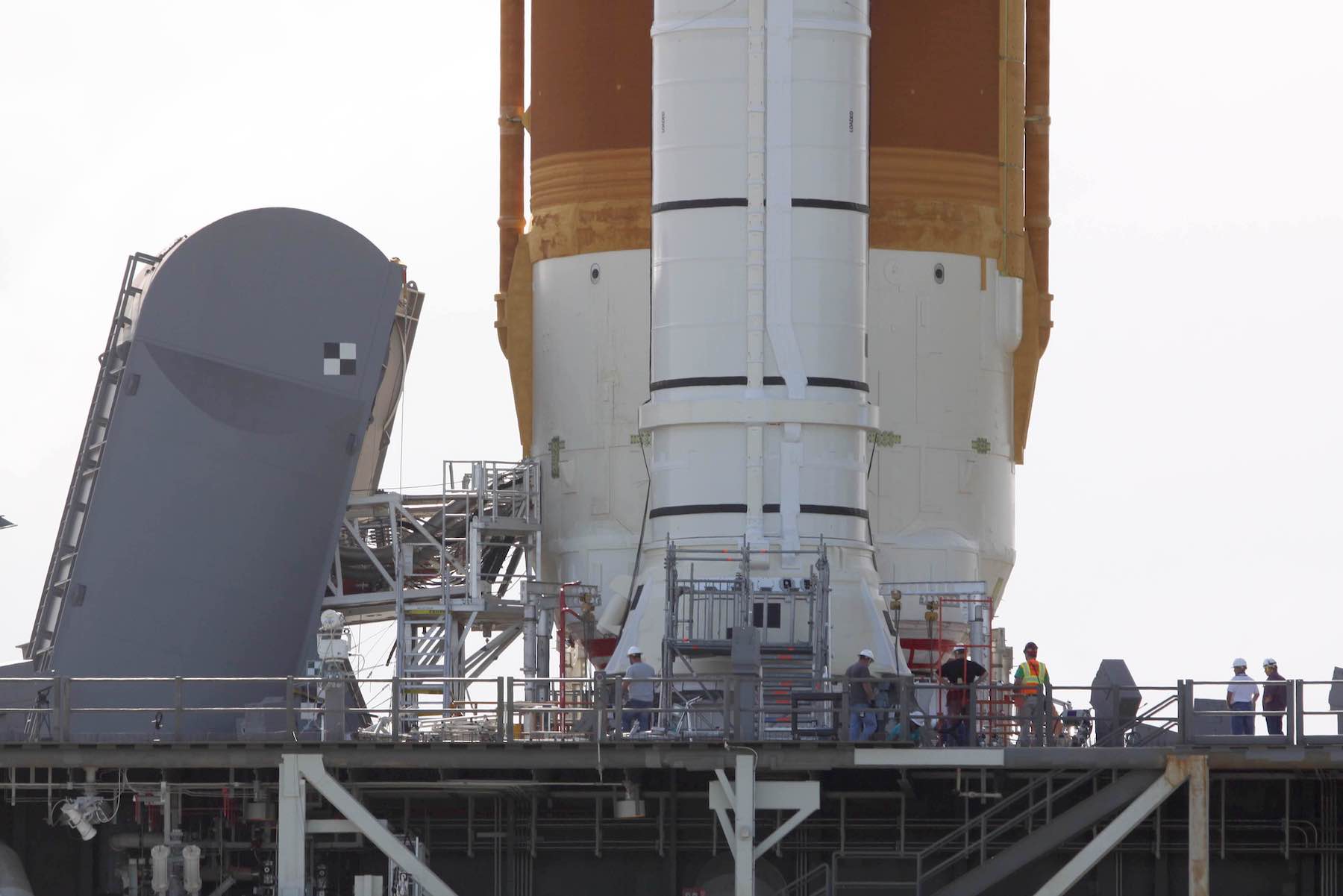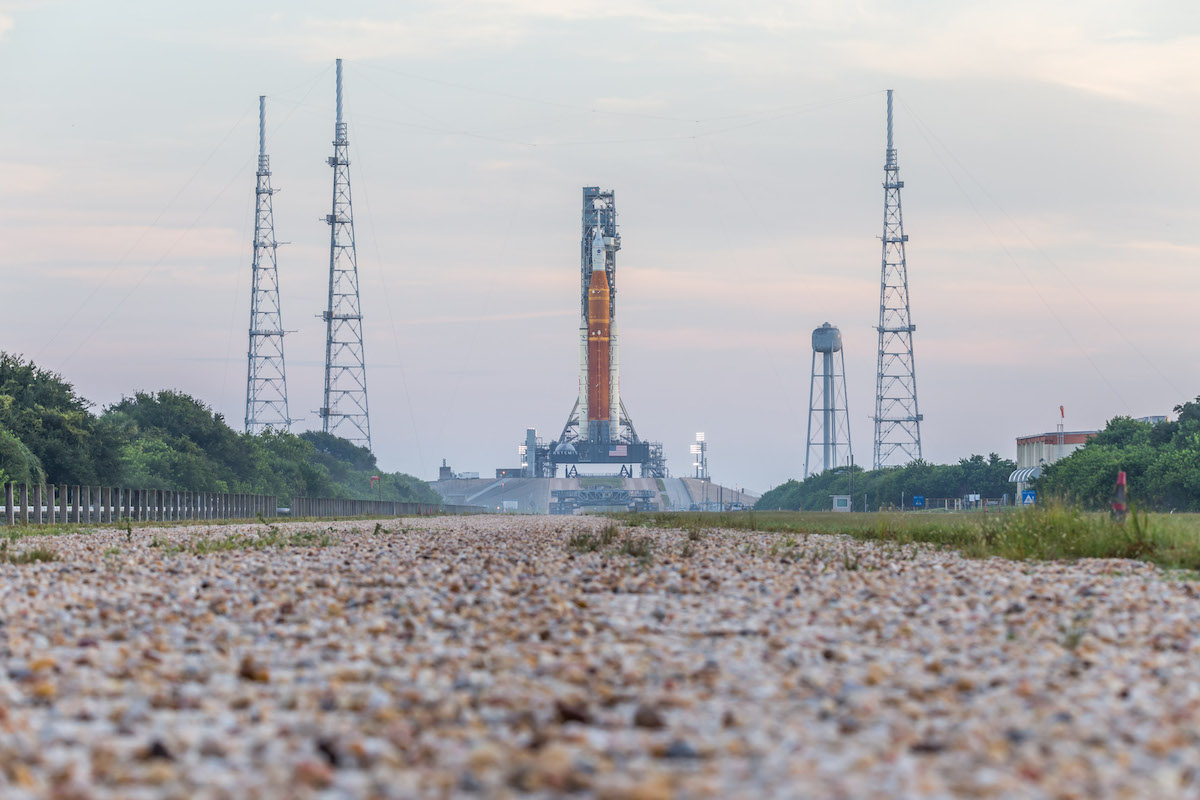Space News & Blog Articles
Final week of Artemis 1 preps include Orion closeouts and booster servicing
 A member of NASA’s Artemis ground team is seen inside the white room near the Orion spacecraft’s hatch during rollback of the Space Launch System moon rocket to the Vehicle Assembly Building on July 2. Credit: Stephen Clark / Spaceflight Now
A member of NASA’s Artemis ground team is seen inside the white room near the Orion spacecraft’s hatch during rollback of the Space Launch System moon rocket to the Vehicle Assembly Building on July 2. Credit: Stephen Clark / Spaceflight Now
Ground teams at NASA’s Kennedy Space Center will load fuel into the Space Launch System moon rocket’s steering system and finish closeouts inside the Orion capsule on top of the launcher this week, setting the stage for the start of the two-day countdown sequence Saturday and liftoff Monday.
NASA cleared the 322-foot-tall (98-meter) moon rocket for its first launch after a flight readiness review Monday at Kennedy, but major milestones remain ahead of the launch team in the final week before liftoff on the unpiloted Artemis 1 test flight.
“Getting your license to fly represents a significant milestone,” said Mike Sarafin, NASA’s Artemis 1 mission manager. The readiness review was a “thorough wire-brushing” of the status of launch preps, he said.
“Is the rocket ready? Is the spacecraft ready? Are all the teams ready?”
Managers concluded that all systems are ready to proceed into the final phase of launch preparations. NASA officials are hopeful everything will come together for launch next Monday during a two-hour window opening at 8:33 a.m. EDT (1233 GMT).
But there are still hurdles ahead for NASA’s launch team. The two-day countdown is set to begin at 10:23 a.m. EDT (1423 GMT) Saturday, setting up for a critical milestone
The Artemis 1 mission will send NASA’s human-rated Orion spacecraft into a distant orbit around the moon. The 42-day mission will conclude with the Orion capsule’s parachute-assisted splashdown in the Pacific Ocean on Oct. 10, assuming the flight takes off Aug. 29.
The SLS moon rocket is the most powerful launcher ever developed by NASA, as measured by total thrust. The 8.8 million pounds of thrust produced by the rocket’s four liquid-fueled Aerojet Rocketdyne RS-25 core stage engines and two Northrop Grumman-built solid rocket boosters amounts to nearly 15% more power than NASA’s Saturn 5 moon rocket from the Apollo program.
The rocket is central to NASA’s Artemis program, with the goal of returning astronauts to the surface of the moon later this decade. If the Artemis 1 test flight goes well in the coming weeks, NASA plans to equip the second SLS moon rocket and a crew-rated Orion spacecraft for the Artemis 2 mission in 2024 to send four astronauts on a trip around the moon.
Future Artemis flights will involve commercial moon landers and a mini-space station to be built in orbit around the moon.
 The Artemis 1 moon rocket’s two solid rocket boosters, one of which is seen here, use hydraulic power units to drive their nozzle gimbaling system to steer the launcher after liftoff. Credit: Stephen Clark / Spaceflight Now
The Artemis 1 moon rocket’s two solid rocket boosters, one of which is seen here, use hydraulic power units to drive their nozzle gimbaling system to steer the launcher after liftoff. Credit: Stephen Clark / Spaceflight Now
NASA rolled the SLS moon rocket to Launch Complex 39B at Kennedy last week from the Vehicle Assembly Building, where technicians completed final checks on the vehicle not possible at the launch pad.
Charlie Blackwell-Thompson, the Artemis 1 launch director at Kennedy, said ground crews at pad 39B connected propellant, electrical, and command and control systems between the pad 39B and the SLS mobile launch platform after the rocket arrived at the pad last Wednesday.
Early Tuesday, teams at pad 39B are expected to begin loading the steering, or gimbaling, mechanisms on the rocket’s two solid-fueled boosters with hydrazine fuel, which feeds hydraulic power units in the booster thrust vector control system.
On the Orion spacecraft mounted atop the SLS moon rocket, ground crews have installed final biological experiments, radiation dosimeters and a voice-activated crew interface technology demonstration payload named Callisto inside the pressurized crew module.
Teams closed the side hatch to the Orion spacecraft Monday. The hatch will be reopened later this week for technicians to enter the Orion crew cabin for final closeouts, such as removing covers from the ship’s windows, according to Howard Hu, NASA’s Orion program manager at the Johnson Space Center in Houston.
The ground crew will also place the mission’s “zero-g indicator” inside the Orion crew capsule. Human space missions traditionally carry a stuffed toy to float about the cabin once the spacecraft reaches orbit.
Artemis 1’s zero-g indicator is a stuffed Snoopy.
The Orion hatch will be closed late this week for the final time before launch, clearing the way for the start of the countdown Saturday morning.
The crew access arm on the SLS mobile launcher tower will be retracted Sunday, and managers will meet late Sunday night to decide whether to begin loading more than 750,000 gallons of super-cold liquid hydrogen and liquid oxygen propellants into the rocket’s core stage and upper stage.
If officials give approval for tanking, propellants will begin flowing into the SLS core stage tanks shortly after 1 a.m. EDT (0500 GMT) Monday.
 Credit: Alex Polimeni / Spaceflight Now
Credit: Alex Polimeni / Spaceflight Now
NASA attempted four countdown demonstration tests on the SLS moon rocket in April and June, culminating June 20 with the first time the launch team fully loaded the launcher with liquid propellants.
NASA was satisfied with that test, which ended with a cutoff with about 29 seconds left in the countdown. Teams moved the moon rocket back to the assembly building July 2 for final testing, closeouts, and the repair of a minor hydrogen leak discovered during the June 20 test.
During a real countdown, the hydrogen leak would have forced NASA to scrub the launch attempt. But engineers bypassed the leak, traced to a four-inch quick-disconnect fitting in a “bleed line” that flows cryogenic liquid hydrogen from the core stage tank to the engine section.
The liquid hydrogen bleed into the engine section helps thermally condition the rocket’s RS-25 main engines for the ignition sequence. Technicians believe they repaired the leak when the SLS moon rocket was back in the VAB last month, but the plumbing of the rocket’s propulsion system will contract when exposed to the super-cold shock of liquid hydrogen.
That could reveal a leak that was not detectable at ambient temperatures inside the Vehicle Assembly Building. The leaky quick-disconnect is located in the tail service mast umbilical, which routes propellants between the mobile launch platform and the rocket itself.
Blackwell-Thompson, the Artemis 1 launch director, said the launch team will test out the liquid hydrogen bleed function once the core stage’s liquid hydrogen tank is full, some time after 4 a.m. EDT (0800 GMT) if the countdown is proceeding on schedule. That procedure has to work to allow the launch to proceed, officials said.
A final built-in hold is planned at T-minus 10 minutes, when members of the launch team will voice their final “go” or “no go” for launch. The ground launch sequencer computer will take control of the countdown at T-minus 10 minutes and counting, overseeing final steps to configure the SLS moon rocket and Orion spacecraft for liftoff.
The ground launch sequencer computer will step through several major checkpoints in the countdown, including pressurization of the rocket’s four cryogenic propellant tanks, and the transition of the United Launch Alliance-built upper stage and Boeing-built core stage to internal battery power. The core stage’s auxiliary power unit will also switch on, supplying hydraulic pressure to the main engine steering system.
The four RS-25 engine nozzles, leftover hardware from the space shuttle program, will vector through a steering profile in the final three minutes of the countdown.
The rocket’s on-board computer will take command of the countdown at T-minus 30 seconds. That was the point when the countdown wet dress rehearsal June 20 ended. The countdown stopped automatically at T-minus 29 seconds when the rocket’s computer detected the engines were not properly conditioned for ignition, due to the leak in the hydrogen bleed line.
NASA hoped to proceed down to T-minus 9 seconds.
“During wet dress, we got down to T-minus 29 seconds, so we’re looking forward to getting those last 29 seconds off the countdown clock, and there’s a lot of dynamics that happen as you get down close to engine start,” Blackwell-Thompson said.
The engines will ignite at T-minus 6 seconds and ramp up to full power, each producing 418,000 pounds of thrust at sea level at 109% throttle. If all four engines are healthy, the rocket will send the command to ignite its two side-mounted boosters to propel the launcher off pad 39B.
This email address is being protected from spambots. You need JavaScript enabled to view it. the author.
Follow Stephen Clark on Twitter: @StephenClark1.
When you subscribe to the SpaceZE News Feed, we will send you an e-mail when there are new updates on the site so you wouldn't miss them.

